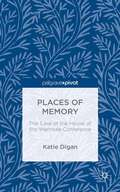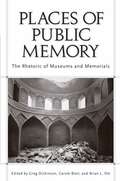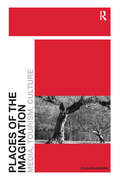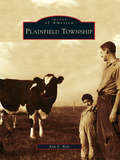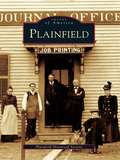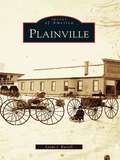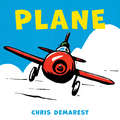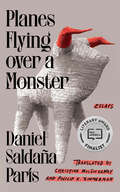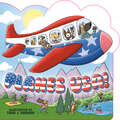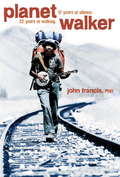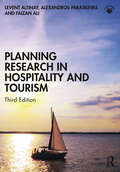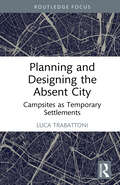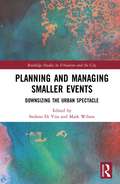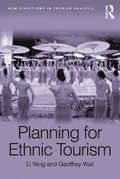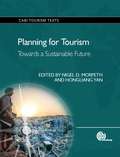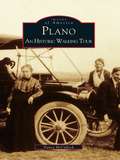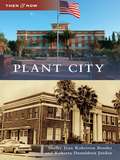- Table View
- List View
Places of Memory: The Case of the House of the Wannsee Conference
by Katie DiganPlaces of Memory examines the post-war history of the site where the 1942 Wannsee Conference was held. The author analyses the different uses of the house to investigate how a site turns into a site of memory.
Places of Public Memory: The Rhetoric of Museums and Memorials (Rhetoric, Culture, and Social Critique)
by Carole Blair Brian L. Ott Greg Dickinson<p>Though we live in a time when memory seems to be losing its hold on communities, memory remains central to personal, communal, and national identities. And although popular and public discourses from speeches to films invite a shared sense of the past, official sites of memory such as memorials, museums, and battlefields embody unique rhetorical principles. <p>Places of Public Memory: The Rhetoric of Museums and Memorials is a sustained and rigorous consideration of the intersections of memory, place, and rhetoric. From the mnemonic systems inscribed upon ancient architecture to the roadside accident memorials that line America's highways, memory and place have always been deeply interconnected. This book investigates the intersections of memory and place through nine original essays written by leading memory studies scholars from the fields of rhetoric, media studies, organizational communication, history, performance studies, and English. The essays address, among other subjects, the rhetorical strategies of those vying for competing visions of a 9/11 memorial at New York City's Ground Zero; rhetorics of resistance embedded in the plans for an expansion of the National Civil Rights Museum; representations of nuclear energy both as power source and weapon in Cold War and post Cold War museums; and tours and tourism as acts of performance. <p>By focusing on official places of memory, the collection causes readers to reflect on how nations and local communities remember history and on how some voices and views are legitimated and others are minimized or erased.</p>
Places of the Imagination: Media, Tourism, Culture
by Stijn ReijndersRecent years have seen an explosive growth in the phenomenon of people visiting locations from popular novels, films or television series. Places of the Imagination presents a timely and insightful analysis of this form of media tourism, exploring the question of how best to explain the increasing popularity of media tourism within contemporary culture. Drawing on extensive empirical and interview material, this book examines the representation of landscapes in popular narratives that have inspired media tourism, whilst also investigating the effects over time of such tourism on local landscapes, and the processes by which tourists appropriate the landscape, experiencing and accommodating them into their imagination. Oriented around three central case studies of popular television detective shows, famous films and classic literature, Places of the Imagination develops a new theoretical understanding of media tourism. As such, it will appeal to sociologists and cultural geographers, as well as those working in the fields of media and cultural studies, popular and fan culture, tourism and the sociology of leisure.
Plain Buggies: Amish, Mennonite, And Brethren Horse-Drawn Transportation. People's Place Book N (People's Place Bks.)
by Stephen ScottAccessible in style, Plain Buggies presents the most complete work on the transportation modes of the "plain people" published to date. includes details on prices, styles, laws, stories. Why do 100,000 persons in North America refuse to drive cars for religious reasons? What are the main styles among the 90-some variations of their vehicles? What does a horse's face tell you about its personality? What about accidents, the law, and harassment? How much does a buggy cost in various states? How long does it last? Are they sold second-hand?
Plain Chinglish
by Oliver Lutz RadtkePlain Chinglish offers an insightful look at misuses of the English language in Chinese street signs, products, and advertising. Menu translations such as “Chicken scratched in front of a peice of noodles,” safety notices such as “Prohibition against door,” and public education signs such as “Labor glorious, Lazy shamefull” will make readers laugh out loud. A long-standing favorite of English speaking tourists and visitors, you can enjoy 120+ brand-new examples of this unique cultural heritage from the comfort of your own home.
Plainfield Township
by Ann ByleLovely plains and beautiful fields greeted settlers eager to put down roots in the area north of the growing city of Grand Rapids. The northernmost point of the Grand River and its environs, including the Rogue River joining the Grand nearby, offered folks everything they needed: river and road travel, good farmland, plenty of forestland, and enough space to grow and prosper. Soon the area was known as Plainfield Township, with the bustling Plainfield Village at its center. Small communities grew up around the township, including Belmont and Comstock Park that exist today but also Konkle Town and Childsdale, which do not. Plainfield Village is gone as well, but the spirit of those early pioneers lives on. Today Plainfield Township is a combination of city and country, businesses and farms, and longtime residents and those just discovering the beauty of this area that still boasts plains and fields.
Plainfield: Views Of Plainfield Connecticut (Images of America)
by Plainfield Historical SocietyThere are two dozen places in the United States named Plainfield, but Plainfield, Connecticut, was the first. When it was incorporated in 1699, Colonial governor Fitz-John Winthrop named the town for its rich, fertile fields along the Quinebaug River. During the 1700s, the town was transformed from Native American country to a farming community populated by English settlers. In the 1800s, textile mills were built along the Moosup and Quinebaug Rivers, and Plainfield became an industrial town attracting workers from all over New England, Canada, and Europe. Today the textile industry is gone, and the surviving mills have been converted to other uses. Located in the northeastern part of the state, Plainfield is in the heart of the breathtaking Quinebaug-Shetucket National Heritage Corridor.
Plainville
by Lynda J. RussellOriginally known as the Great Plain, Plainville was the last town to separate from Farmington. In 1830, a post office was established in the new community and the name was changed. The town officially incorporated in 1869. The early economy consisted of farmers, millers, tin workers, tanners, chair makers, and blacksmiths. In 1828, the Farmington Canal opened and Plainville's population blossomed. It soon became a commercial center and new industries and manufacturing developed. This book documents Plainville's early-17th-century settlers, such as the Root, Newell, Hooker, Lewis, and Hamlin families, and follows the town's fascinating evolution to the present. Through stunning photographs, readers will delight to see Plainville's past unfold.
Plane
by Chris DemarestChris Demarest's Plane gets a refreshing update for the littlest listeners, but keeps its melodic charm. Plane lifts, soars high. Far below towns lie.The sky's the limit in this rhyming book from Chris Demarest. Perfect for little ones ready to soar. Check out Demarest's other transportation books, Bus, Ship, and Train, for more on-the-go charm!
Plane Insanity: A Flight Attendant's Tales of Sex, Rage, and Queasiness at 30,000 Feet
by Elliott HesterYou're belted into a middle seat with burly businessmen on either side. It's 92 degrees in the cabin and someone forgot to use deodorant. A baby screams. A kid kicks the back of your seat. After two hours you haven't even left the taxiway. Welcome to modern airline travel! In Plane Insanity, Elliott Hester delivers stories that could only come from someone who "rides tin" for a living-a flight attendant. You'll hear about:* the passenger from hell* a smuggled python* prostitutes working the lavatories* a riot in coach-class* a heist* the anatomy of a carryon bag* a malodorous couple* the Mile-High Club * and more!Fasten your seatbelts. After Plane Insanity, you'll never think of air travel the same way again.
Planes Flying over a Monster: Essays
by Daniel Saldaña ParísFinalist for the PEN Translation Prize From one of Mexico&’s most exciting young writers, a cosmopolitan and candid essay collection exploring life in cities across the world and reflecting on the transformative importance of literature in understanding ourselvesIn ten intimate essays, Daniel Saldaña París explores the cities he has lived in, each one home to a new iteration of himself. In Mexico City he&’s a young poet eager to prove himself. In Montreal—an opioid addict desperate for relief. In Madrid—a lonely student seeking pleasure in grotesque extremes. These now diverging, now coalescing selves raise questions: Where can we find authenticity? How do we construct the stories that define us? What if our formative memories are closer to fiction than truth? Saldaña París turns to literature and film, poetry and philosophy for answers. The result is a hybrid of memoir and criticism, "a sensory work, full of soundscapes, filth, planes, closed spaces, open vastness" (El País).
Planes USA!
by Jo ParkerExplore America in this cloud-shaped board book! Buckle up and grab a seat on this plane full of pups, pooches, and other fun animals!Welcome aboard! Flying from New York to L.A., and making stops along the way... See 12 exciting cities across the USA!
Planes, Trains, and Auto-Rickshaws
by Laura Pedersen"It is Pedersen's gift to be able to draw the reader into her world." --Front Street Reviews "[Pedersen's] wicked, sarcastic, dry, self-deprecating sense of humor won me over and I absolutely loved it start to finish."--Printed Page, of Buffalo Gal India today is a nation caught between the rich heritage of its past and the great economic potential of its future. In this witty and insightful book, journalist and author Laura Pedersen reveals the tensions and contradictions facing the emerging world power. In particular, Pedersen explores the roles of women and children in India today, providing insight into this important and often neglected issue. Part travelogue, part history, and part cultural reflection, Planes, Trains, and Auto-Rickshaws provides an intimate glimpse of a nation at its turning point. It is a must-read for those who want to understand India beyond the headlines. Laura Pedersen has written for The New York Times and is the author of several books including Play Money, Going Away Party, Beginner's Luck (chosen as a Barnes & Noble Discover Great New Writers selection), Buffalo Gal, and Buffalo Unbound. In 1994 President Clinton honored her as one of Ten Outstanding Young Americans. She has appeared on Oprah, Good Morning America, Primetime Live, and The Late Show with David Letterman, and she writes for several well-known comedians. Pedersen lives in New York City.
Planetwalker: 22 Years of Walking. 17 Years of Silence.
by John FrancisWhen the struggle to save oil-soaked birds and restore blackened beaches left him feeling frustrated and helpless, John Francis decided to take a more fundamental and personal stand - he stopped using all forms of motorized transportation. Soon after embarking on this quest that would span two decades and two continents, the young man took a vow of silence that endured for 17 years.
Planning Research in Hospitality & Tourism
by Levent Altinay Alexandros ParaskevasPlanning Research in Hospitality and Tourism provides a concise and clear approach to planning research projects which are a necessity in most hospitality and tourism courses taught at degree level. The text considers the particular characteristics of the hospitality and tourism industry, whilst providing a balanced approach toward both quantitative and qualitative methods of research. The text also carefully considers the international aspect of the industry and the people it employees, which supports the books aims of:* Providing an excellent understanding of the basic principles of conducting research, in a straight forward “no nonsense” guide* Carefully considering the particular characteristics of the hospitality and tourism sectors in relation to embarking on a research project in the area* Including in each chapter an “International Dimension” section, as well as case studies, questions and reflections on the research process
Planning Research in Hospitality and Tourism
by Levent Altinay Soocheong Shawn Jang Alexandros ParaskevasPlanning Research in Hospitality and Tourism provides an accessible, concise and practical guide to planning, conducting and analysing research in tourism and hospitality. The authors skilfully introduce the basic principles and techniques of research in the international hospitality and tourism sectors, and provide detailed guidance on both quantitative and qualitative methods of research. It includes a variety of features throughout to aid students' understanding and offers practical tips to help students overcome any potential research issues. Building on the success of the first edition, the volume has been fully revised and updated, and contains new chapters on mixed methods and how to make best use of recent technology in research practices. The second edition also benefits from: * increased coverage of research design strategies including sampling, ethnography and experimental design * inclusion of computer-mediated data collection techniques, such as online interviews, online focus groups and online observation (netnographic research) * new and updated international case studies and extracts, with a more even spread of tourism and hospitality examples of research * online student and lecturer resources, including PowerPoint slides and a test bank of multiple choice and true/false questions for each chapter. Written by three leading scholars with experience of both the industry and university courses globally, this insightful text is an essential resource for all tourism and hospitality research students and early career research professionals around the world.
Planning Research in Hospitality and Tourism
by Levent Altinay Alexandros Paraskevas Faizan AliPlanning Research in Hospitality and Tourism, third edition is an accessible, concise and practical guide to planning, conducting and analysing research in tourism and hospitality.International in scope and appeal, this book provides students with an introduction to the basic principles, research techniques and characteristics of research in the international hospitality and tourism sectors in a straightforward and accessible way. It includes a variety of features throughout to aid understanding and offer practical tips of overcoming potential research issues.This new edition has been fully updated to include: New chapters on mixed methods and how to adopt technology into research practices More coverage of research strategies, focus groups, sampling secondary research as well as experimental design New and updated international case studies and extracts from journals, providing real examples of tourism and hospitality research scenarios Student and lecturer online resources, including practice datasets for students Enriched with insightful case studies throughout, this volume is essential reading for all tourism and hospitality researchers.
Planning Your Gap Year: Hundreds Of Opportunities For Employment, Study, Volunteer Work And Independent Travel
by Nick VandomeThe diversity of gap year opportunities on offer is such that it is only limited by your imagination or your ambition. Packed with ideas on where to go and what to do, this guidebook will make your planning easier. OVER 220 CONTACT ORGANISATIONS VALUABLE ADVICE ON HEALTH AND SAFETY USING THE INTERNET FOR RESEARCH - AND WHEN YOU'RE OUT THERE PERSONAL ACCOUNTS FROM PEOPLE WHO'VE BEEN THERE AND DONE IT WRITTEN FOR SCHOOL AND UNIVERSITY LEAVERS, VOLUNTEERS AND MID CAREER YEAR-OUTERS
Planning Your Gap Year: Hundreds of Opportunities for Employment, Study, Volunteer Work and Independent Travel
by Nick VandomeThe diversity of gap year opportunities on offer is such that it is only limited by your imagination or your ambition. Packed with ideas on where to go and what to do, this guidebook will make your planning easier. OVER 220 CONTACT ORGANISATIONS VALUABLE ADVICE ON HEALTH AND SAFETY USING THE INTERNET FOR RESEARCH - AND WHEN YOU'RE OUT THERE PERSONAL ACCOUNTS FROM PEOPLE WHO'VE BEEN THERE AND DONE IT WRITTEN FOR SCHOOL AND UNIVERSITY LEAVERS, VOLUNTEERS AND MID CAREER YEAR-OUTERS
Planning and Designing the Absent City: Campsites as Temporary Settlements
by Luca TrabattoniThis book concerns the study of open-air accommodation facilities. The market evolutions allow us to look at these structures as temporary settlements characterised by a low-density dwelling and a close connection with natural elements and the landscape.This new and different point of view is sustained by the tendency of outdoor tourism to go in the direction of temporary villages, and this tendency is directly related to "time" and "landscape". The landscape is the reason why the campsite is settled. The time is linked to the holiday season timing. Today, both are greatly influenced by the introduction of the "Maxi-Caravan". This removable living unit can be placed on the empty pitch, occupying the landscape without ruining the soil. By the settlement of Maxi-Caravans, the campsite is transformed from an empty landscape with tents to a temporary settlement, whose timing is divided between the seasonal timing of the campsite and the "timing" of the product, and whose landscape is organised by the relation with the prevalent landscape and the internal one. The book's core defines the outdoor facility structure, using Italy as the main case study. To identify design strategies, the book analyses temporary settlement examples (quick time) and projects from historic outdoor tourism (medium time). Finally, the last chapter reflects on open-air accommodation facilities by showing their applicability in the different contexts of the refugee camps (long time).The aim of this research is to enhance the theme of open-air accommodation facilities, highlighting the need to equalise the study of temporary settlements with that of permanent settlements. It will be of interest to researchers and students of planning, landscape and tourism.
Planning and Managing Smaller Events: Downsizing the Urban Spectacle (Routledge Studies in Urbanism and the City)
by Stefano Di VitaPlanning and Managing Smaller Events: Downsizing the Urban Spectacle explores the role of smaller-scale events in contributing to the renewal and development of urban societies. This book adopts a case study approach to examine a diverse range of events taking place in towns and cities in Europe, Asia and North America. This volume begins by defining and classifying these kinds of events and then verifying if and how they can provide opportunities for cities and towns without the disadvantages of world-famous large events. It concludes by discussing the growing regional scale of urban phenomena and their transition in post-metropolitan spaces. Planning and Managing Smaller Events: Downsizing the Urban Spectacle will be of interest to government officials and policy makers involved in economic development, urban planning, parks and arts/culture, as well as students and researchers interested in urbanism, event management, tourism and recreation.
Planning for Ethnic Tourism (New Directions in Tourism Analysis)
by Geoffrey Wall Li YangEthnic tourism has emerged as a means that is employed by many countries to facilitate economic and cultural development and to assist in the preservation of ethnic heritage. However, while ethnic tourism has the potential to bring economic and social benefits it can also significantly impact traditional cultures, ways of life and the sense of identity of ethnic groups. There is growing concern in many places about how to balance the use of ethnicity as a tourist attraction with the protection of minority cultures and the promotion of ethnic pride. Despite the fact that a substantial literature is devoted to the impacts of ethnic tourism, little research has been done on how to plan ethnic tourism attractions or to manage community impacts of tourism. This book addresses the need for more research on planning for ethnic tourism by exploring the status and enhancement of planning strategies for ethnic tourism development. The book develops the case of a well-known ethnic tourist destination in China -Xishuangbanna, Yunnan. It analyzes how ethnic tourism has been planned and developed at the study site and examines associated socio-cultural and planning issues. The authors evaluate the perspectives of four key stakeholder groups (the government, tourism entrepreneurs, ethnic minorities and tourists) on ethnic tourism through on-site observation, interviews with government officials, planners and tourism entrepreneurs, surveys of tourists and ethnic minority people, and evaluation of government policies, plans and statistics. This book is unique in its emphasis on planning and in its focus on China, rapidly emerging as a major player in tourism, with applications for tourism around the world.
Planning for Tourism: Towards a Sustainable Future (CABI Tourism Texts)
by Ian Brown Ian Tempest Craig Grimes Kathryn Beardmore Sofia Teixeira Eurico Dr Filareti Kotsi Dr Nour Farra-HaddadThis text provides an innovative approach to the pedagogy of contemporary planning processes within different cultural contexts globally. It adopts an innovative multi-disciplinary social science approach and through the inclusion of international case studies, considers the extent to which intelligent design has enabled the needs of disabled residents and visitors to have universal access to social spaces and facilities. In incorporating the consideration into the fabric of the book it will encourage the mainstreaming of universal design and accessible tourism, as keystones of planning processes within the C21st.
Plano: An Historic Walking Tour
by Nancy MccullochThe history of Plano, Texas is as rich as the soil that attracted early settlers to the area in the mid to late 1800s. Vividly portrayed here in over 200 images, author Nancy McCulloch recreates for the reader the remarkable history of this forward-thinking town. A large number of residents from Kentucky and Tennessee were attracted to the rich black soil and farming prospects of this part of Peters Colony. Sam Houston, as a former governor of Tennessee, enticed families from these states to travel to the Plano area and seek out a new and better way of life. From 1870 to 1886, Plano's population expanded tenfold. As early as the late 1800s the community developed a reputation for progressive thinking and beautiful homes.
Plant City
by Roberta Donaldson Jordan Shelby Jean BenderNamed for railroad magnate Henry B. Plant, Plant City was incorporated in 1885. Rich in history and the flavor of strawberries, it is known as the Winter Strawberry Capital of the World. Images featured are from the Quintilla Geer Bruton Archives Center and the East Hillsborough Historical Society. Shelby Jean Roberson Bender, an eighth-generation Floridian, and Roberta Donaldson Jordan, a native of Pennsylvania, have devoted many years to historical and genealogical research, publications, and instruction.
